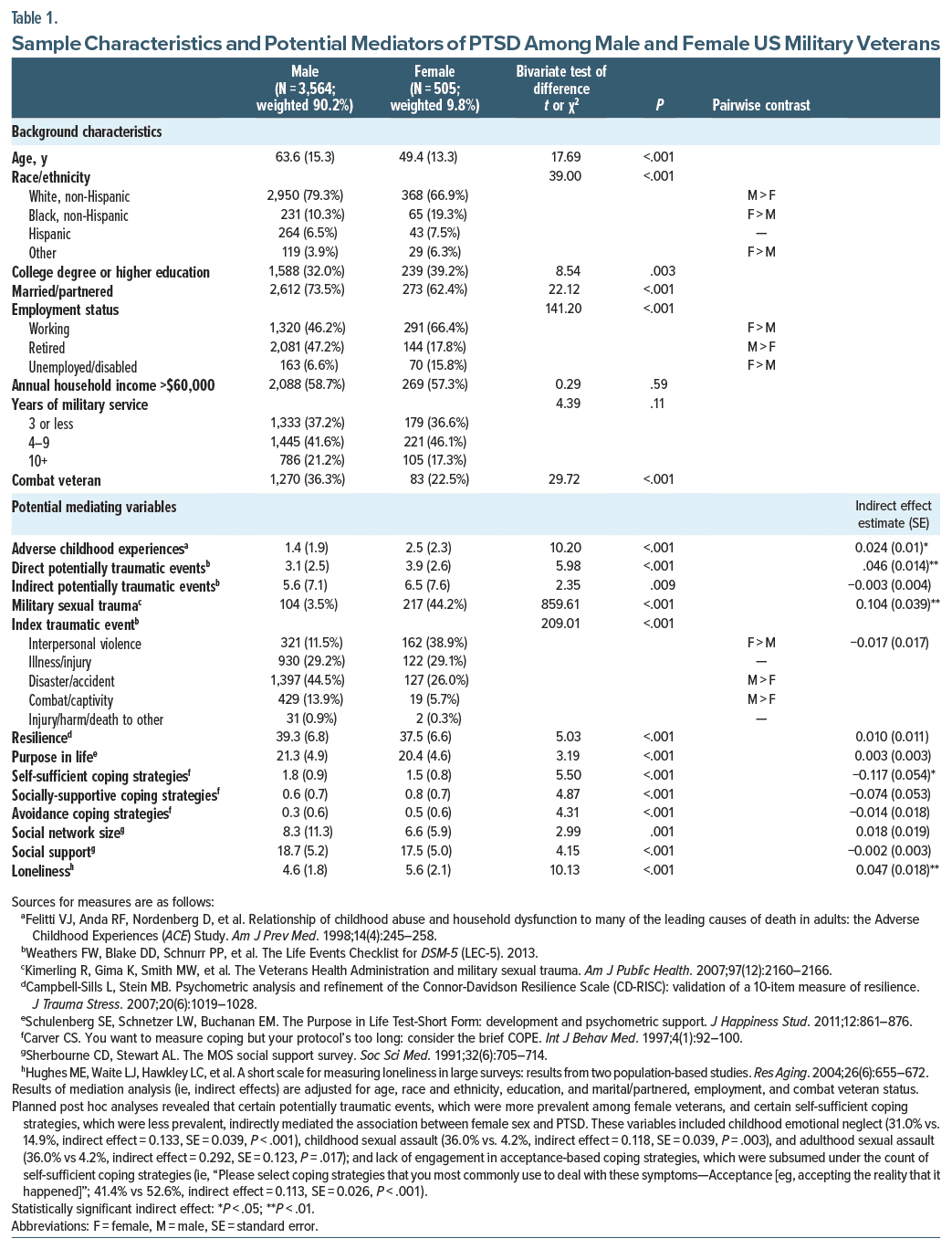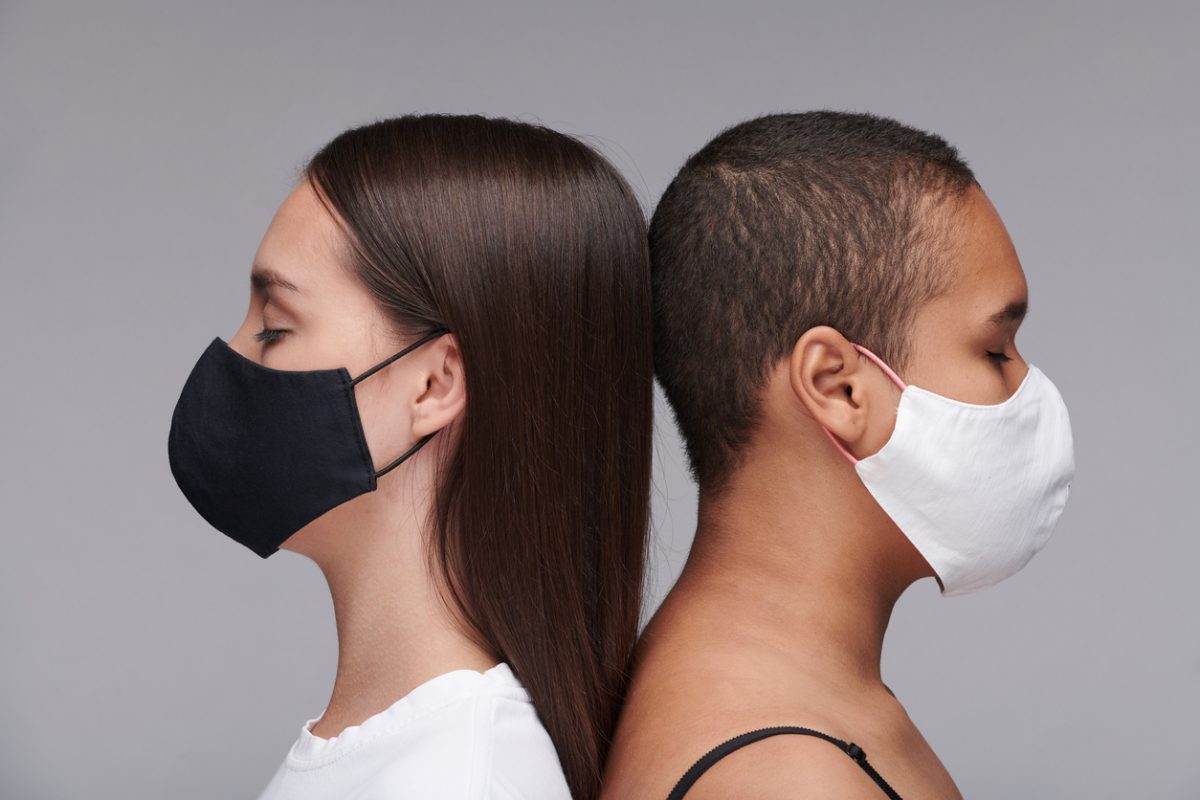A higher prevalence of posttraumatic stress disorder (PTSD) among females has been consistently documented.1 For example, a nationally representative study of the US adult population found that the prevalence of lifetime PTSD was 8.0% in females and 4.1% in males.2 This difference is especially evident among military veterans, in whom experiences such as military sexual trauma (MST), which is more prevalent among females, may place female veterans at greater risk for PTSD.3 Despite considerable attention to this sex difference,1–6 however, scarce research has examined factors that may contribute to it.
Sex differences in PTSD prevalence may be attributable to differences in trauma exposures (eg, adverse childhood experiences, sexual trauma), psychological traits (eg, resilience), and social factors (eg, loneliness).4–8 Here, we analyzed data from a nationally representative sample of US veterans to examine how a wide range of such factors might indirectly account for sex differences in PTSD.
Methods
Sample. Participants were drawn from the National Health and Resilience in Veterans Study (NHRVS), which surveyed a nationally representative sample of 4,069 U.S. veterans from KnowledgePanel, a probability based, online survey panel.
Measures. PTSD symptoms were assessed using the PTSD Checklist for DSM-5, with a score ≥31 indicative of a positive screen for PTSD (α = 0.96).9 Table 1 lists other measures.
Data Analysis. Chi-square and independent samples t tests were conducted to compare study variables by sex and identify possible mediating variables. An exploratory mediation analysis was then conducted to identify indirect factors that influence the relationship between sex and PTSD; trauma, psychological trait, and social variables that differed by sex (P < .05) in bivariate analyses were entered as potential mediators, and sociodemographic and military variables as covariates.
Results
Table 1 shows sample characteristics and potential mediating variables. Female veterans were 2.5 times more likely than male veterans to screen positive for PTSD, N = 66 (weighted 15.5%) vs N=174 (weighted 6.2%), χ2 = 46.89, P < .001. However, the direct effect of female sex in predicting PTSD was no longer significant after accounting for indirect effects of trauma, psychological trait, and social variables (P = .51). Collectively, the indirect effect of these factors accounted for 81.2% of the total effect of sex in predicting PTSD, with direct potentially traumatic events, loneliness, and MST having the strongest magnitude indirect effects (Table 1).
Discussion
Using data from a large, nationally representative sample of US veterans, we found that sex differences in PTSD were attributable to differential exposure to certain traumatic events, such as childhood sexual assault and MST, and social factors, such as greater loneliness. Lack of engagement in acceptance-based coping strategies also indirectly mediated the association between being female and screening positive for PTSD. This finding may be explained in part by higher rates of sexual trauma among female veterans, as previous research has found that sexually traumatized individuals often have difficulty acknowledging and processing painful emotions.10 Taken together, these findings extend prior work4,5,7,8,11 to emphasize the importance of targeting childhood and sexual trauma, and loneliness, and bolstering acceptance-focused coping in the treatment of PTSD among female veterans. One limitation of this study is that it focused solely on binary categories of biological sex without considering the roles of gender or the experiences of nonbinary and transgender individuals. Further, given the cross-sectional study design, temporal relationships among variables are unclear, and it is possible that sex may moderate associations between risk factors for PTSD.
Nevertheless, these findings provide an empirical foundation for further research to evaluate longitudinal relationships among risk factors for PTSD, and evaluate prevention and intervention efforts targeting sex- and gender-sensitive risk factors for PTSD among military veterans and other trauma-exposed populations.
Article Information
Published Online: December 16, 2024. https://doi.org/10.4088/JCP.24br15621
© 2024 Physicians Postgraduate Press, Inc.
J Clin Psychiatry 2025;86(1):24br15621
Submitted: September 18, 2024; accepted October 17, 2024.
To Cite: Yang R, Fischer IC, Na PJ, et al. Sex differences in PTSD among US military veterans: role of trauma, coping, and social factors. J Clin Psychiatry. 2025;86(1): 24br15621.
Author Affiliations: Department of Psychology, Harvard University, Cambridge, Massachusetts (Yang); US Department of Veterans Affairs National Center for PTSD, VA Connecticut Healthcare System, West Haven, Connecticut (Fischer, Na, Pietrzak); Department of Psychiatry, Yale School of Medicine, New Haven, Connecticut (Fischer, Na, Mazure, Pietrzak); VA Connecticut Healthcare System, West Haven, Connecticut (Na); Women’s Health Research at Yale, Yale School of Medicine, New Haven, Connecticut (Mazure); Department of Social and Behavioral Sciences, Yale School of Public Health, New Haven, Connecticut (Pietrzak).
Corresponding Author: Robert H. Pietrzak, PhD, MPH, National Center for PTSD, VA Connecticut Healthcare System, 950 Campbell Ave 151E, West Haven, CT 06516 ([email protected]).
Relevant Financial Relationships: None.
Funding/Support: None.
Acknowledgments: The authors thank the veterans who participated in the National Health and Resilience in Veterans Study and the Ipsos staff who coordinated data collection.
References (11)

- Tolin DF, Foa EB. Sex differences in trauma and posttraumatic stress disorder: a quantitative review of 25 years of research. Psychol Bull. 2006;132(6):959–992.
- Goldstein RB, Smith SM, Chou SP, et al. The epidemiology of DSM-5 posttraumatic stress disorder in the US: results from the National Epidemiologic Survey on Alcohol and Related Conditions-III. Soc Psychiatry Psychiatr Epidemiol. 2016;51(8):1137–1148. PubMed
- Haskell SG, Gordon KS, Mattocks K, et al. Gender differences in rates of depression, PTSD, pain, obesity, and military sexual trauma among Connecticut War Veterans of Iraq and Afghanistan. J Womens Health. 2010;19(2):267–271.
- Olff M, Langeland W, Draijer N, et al. Gender differences in posttraumatic stress disorder. Psychol Bull. 2007;133(2):183–204. PubMed
- Christiansen DM, Elklit A. Sex differences in PTSD. In: Ovuga E, ed. Posttraumatic Stress Disorder in a Global Context. InTech; 2012:113–142.
- Kline A, Ciccone DS, Weiner M, et al. Gender differences in the risk and protective factors associated with PTSD: a prospective study of National Guard troops deployed to Iraq. Psychiatry. 2013;76:256–272. PubMed
- Christiansen DM, Hansen M. Accounting for sex differences in PTSD: a multi-variable mediation model. Eu J Psychotraumatol. 2015;6:26068.
- Street AE, Vogt D, Dutra L. A new generation of women veterans: stressors faced by women deployed to Iraq and Afghanistan. Clin Psychol Rev. 2009;29(8):685–694.
- Bovin MJ, Marx BP, Weathers FW, et al. Psychometric properties of the PTSD Checklist for Diagnostic and Statistical Manual of Mental Disorders-Fifth Edition (PCL-5) in veterans. Psychol Assess. 2016;28(11):1379–1391. PubMed
- Roth S, Lebowitz L. The experience of sexual trauma. J Trauma Stress. 1988;1(1):79–107.
- Christiansen DM, Berke ET. Gender- and sex-based contributors to sex differences in PTSD. Curr Psychiatry Rep. 2020;22(4):19.
This PDF is free for all visitors!





